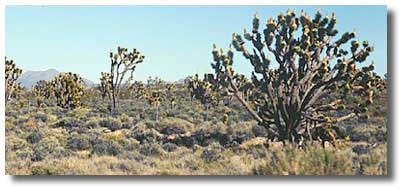 |
 |

|
by Katlyn Adkins 12/18/00 The Mojave Desert is located in southeastern California and portions of Nevada, Arizona and Utah and takes up more than 25,000 square miles. The weather is either extremely hot or extremely cold
with rain fall of about 5".
WILDLIFE How Do Animals Survive the Desert? Fortunately, most desert animals have changed through the years both
behavioral and physiological ways to solve the heat and water problems
the desert environment creates.
Biotic Factors
Abiotic Factors Climate
Soil
Water
Relationships In order to survive, animals depend on other animals, water, and plants. An example is the coyote needs small animals to eat to survive. Small animals like the rabbit need plants to survive. Plants such as the Desert Dandelion need insects to pollinate and water to survive. Food Web
Energy Pyramid |
|
|
|
|
|
|
|
|
|
|
|
|
|
|
|
Environmental Issue Scientists and managers attended a meeting to discuss their concerns about the large areas of Mojave Desert that have been affected by off-highway-vehicle use, overgrazing by domestic livestock, agriculture, urbanization, construction of roads and utility corridors, air pollution and military training exercises. According to USGS scientist and meeting chairperson Dr. Jeff Lovich, "The Mojave Desert is generally perceived by the public to be rugged and timeless. In reality, it is a sensitive ecosystem that is easy to scar and slow to heal. Complete recovery from degradation may require over 3,000 years. |
|
|
|
|
|
|
|
|
